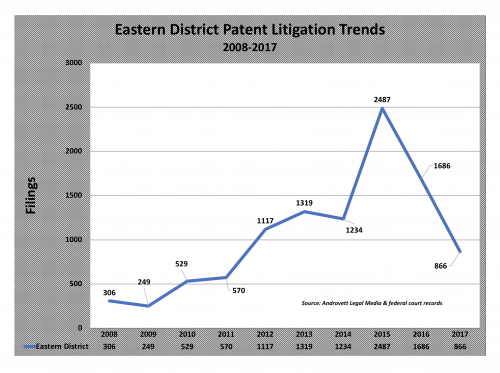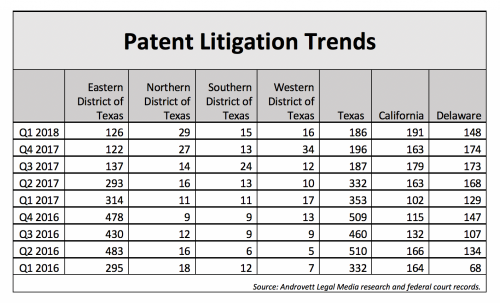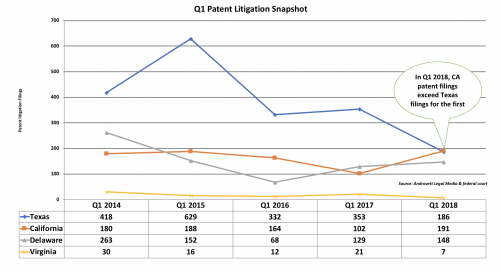For more than a decade, the Eastern District of Texas was the undisputed mecca for patent litigation. Federal courts in Marshall, Sherman, Tyler, Plano and Beaumont often had double or triple the number of patent infringement lawsuits of any other district in the country.
In fact, businesses and individuals in 2015 filed nearly as many lawsuits in East Texas alleging their patents had been violated as the rest of the nation combined.
“We’ve seen this trend coming for a long time.” — Doug Cawley.
One year ago Tuesday, however, the Eastern District’s reign over patent disputes ended when the U.S. Supreme Court issued its landmark decision in TC Heartland v. Kraft Foods that severely restricted the jurisdictions where infringement cases can be filed.
New data obtained by The Texas Lawbook shows that newly filed patent infringement lawsuits are down more than 65 percent in the Eastern District of Texas since the TC Heartland ruling was handed down last May 22 and down 74 percent since 2015.

Statistics now show that there are clear winners and losers in the Supreme Court’s decision. The ruling appears to have dealt a nearly fatal blow to patent trolls. The federal courts in Delaware, the Central District of California and, surprisingly, the Northern District of Texas, have seen their patent dockets increase significantly during the past year.
“We’ve seen this trend coming for a long time,” said patent law expert Doug Cawley, a partner at McKool Smith in Dallas. “Hundreds of cases that used to be filed in the Eastern District are now being filed in other jurisdiction or they just are not being filed at all.”
There were 126 patent infringement lawsuits filed in East Texas federal courts during the first quarter of 2018, which is 60 percent fewer than during the first three months of 2017, according to data research by Androvett Legal Media.
During the past nine months, 385 patent suits were lodged in the Eastern District – down from 1,222 cases during the same period one year earlier, or a 68 percent decline.

A Texas Lawbook analysis of the Androvett statistics shows that an average of 4.5 cases alleging patent breaches were filed daily in the Eastern District in the year leading up to the TC Heartland ruling. Since the decision, the average has fallen to 1.4 complaints per day.
“The decline in the number of patent lawsuits being filed in the Eastern District is not surprising to any lawyer practicing patent litigation,” said Houston patent trial attorney Mike Heim of Heim, Payne & Chorush.
“TC Heartland made it significantly harder for businesses and individuals to sue those who have violated their patents in the Eastern District,” Heim said. “It has become extremely expensive to bring a patent infringement case and it is increasingly difficult to win. The result is fewer cases will be brought.”
National intellectual property experts have claimed that patent infringement cases declined nationally in 2017 and that the Eastern District was merely part of the trend.
But a closer examination of the Androvett data undermines that claim.
There were 4,551 patent infringement cases filed nationally in 2016. In 2017, there were 3,771 – a drop of 780. The same data shows that there were 1,686 patent complaints filed in the Eastern District in 2016, but only 866 such cases in 2017 – a decline of 820.
Without the decline of cases in the Eastern District of Texas, patent litigation nationally would have statistically increased.
“It has become extremely expensive to bring a patent infringement case and it is increasingly difficult to win.” –Mike Heim
The real result of TC Heartland and other recent patent litigation reforms is the decline of lawsuits filed by so-called patent trolls, which are not to be confused with legitimate non-practicing entities (NPEs), which own patents but have never manufactured products. For example, universities and scientists or researchers often make a discovery and have it legally patented with the intent of licensing the discovery to existing businesses. By contrast, trolls sue defendants over illegitimate or highly questionable patents and are willing to settle lawsuits for the mere price of the litigation.
“We have seen nowhere near the activity by patent trolls as we did a year or two ago,” said Munck Wilson managing partner Bill Munck. “There’s an equilibrium that has been achieved.”
While the decline in new patent cases filed in East Texas has been dramatic, intellectual property disputes have not disappeared from Texas.
In fact, statistics show that the Eastern District is still the second favorite jurisdiction in the U.S. for filing infringement complaints. The Northern District, which includes Dallas and Fort Worth, now ranks sixth.

The data shows that the U.S. District Court in Delaware claimed the top spot for most patent lawsuits since the TC Heartland decision. Businesses and individuals filed 148 patent infringement lawsuits in Delaware during the first quarter of 2018 – 15 percent more than were filed in East Texas.
During the past nine months, Delaware federal courts have docketed 495 new patent cases – a 29 percent increase from the year before, according to the Androvett data.
The federal courts in Central District of California, which is home to Los Angeles and Orange County, ranked third during the first quarter of 2018 with 83 new patent cases.
The federal court that witnessed the largest jump in new patent filings was the Northern District of Texas. Twenty-nine patent infringement cases were filed in the North Texas district during the first three months of 2018 – a 164 percent jump over the first quarter of 2017.

“The Northern District developed a patent litigation pilot project years ago in which a handful of judges received enhanced training and expertise in handling patent infringement disputes,” said Munck.
To attract more patent litigation, the Northern District adopted a specialized procedural plan for patent infringement cases that included extra training for four federal judges – Chief Judge Barbara Lynn, Judge David Godbey, Judge Ed Kinkeade and new Judge Karen Gren Scholer.
The Androvett data shows that lawyers filed 70 new patent cases in the Northern District during the past three quarters – up from 32 new filings during the same time period a year earlier.
The Southern District of Texas, which includes federal courts in Houston, Galveston, Corpus Christi and McAllen, also witnessed a significant bump in its patent caseload.
The data shows that the South Texas patent docket added 52 new infringement cases during the past nine months – a 79 percent jump from the year before.
Despite the increase in caseloads in the Northern and Southern districts, the two jurisdictions combined will handle a small fraction of patent cases compared to the Eastern District.
“The expectation that the Eastern District’s patent docket would completely dry up was unrealistic,” Munck said.
Other IP legal experts agree.
“The Eastern District has knowledgeable and experienced judges with well-established rules and procedures,” Heim said. “The Eastern District judges are fast and predictable. There’s a good reason why major companies such as Texas Instruments, AT&T and Whirlpool bring their patent cases in the Eastern District.”
Heim and others say the TC Heartland decision has actually made patent litigation more expensive.
“The Eastern District is extremely efficient because its procedures and processes are well-known and we know the judges and their rulings are more predictable,” said Cawley. “Now, we are in jurisdictions where the rules and procedures are different and unknown and we have no idea who the judges are or how they are likely to decide motions.
“The judges in the Eastern District have worked incredibly hard to make their district the No. 1 jurisdiction in the U.S. for patents,” Cawley said. “As a result, I think the patent docket is here to stay in the Eastern District.”
